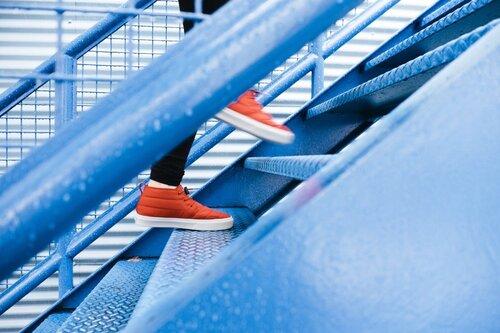
(Note: Some of the links in this post are affiliate links, and we will be compensated when you make a purchase by clicking through our links at no additional cost to you.)
One of the most important things you can do to prevent or manage high blood pressure is to engage in physical activity. When physical activity or exercise is planned and controlled, it can strengthen the heart muscle just as exercise does for other muscles. Regular exercise can do many things for you. It can:
- Help lower blood pressure
- Help you lose weight and maintain a healthy weight
- Relieve stress
- Improve your self-image
- Lowers your risk of developing heart disease
Which Exercise Is Best For High Blood Pressure?
You don’t have to do hard or vigorous exercise to begin benefiting from physical activity. Many activities, such as walking, can be beneficial if done for roughly 30 minutes each day. Or you could go longer. It depends on your interests and whether you’re exercising to achieve a high level of fitness. However, if you haven’ exercise for a while it is perfectly okay if you need to slowly build your fitness levels up over a period of time. For instance, you can start off three times a week for fifteen minutes at a time and then gradually increase your pace, distance and sessions until you are doing a comfortable thirty minutes per session three times a week and then everyday. The point is to get moving in some way and to keep at it.
Whether you exercise regularly or are just starting, use the following recommendations to help lower or control your high blood pressure and strengthen your heart:
- Get started by doing 30 minutes of a moderate-level activity on most, and preferably all, days of the week. Brisk walking, bicycling, and gardening are examples. You can even divide the 30 minutes into shorter periods of at least 10 minutes each. For instance:
- Use stairs instead of an elevator
- Get off a bus one or two stops early
- Park your car at the far end of the lot at work
- Keep track of your steps. According to experts, walking 10,000 steps a day would help control your blood pressure while 6,000 a day will help you maintain your level
of fitness. - Include strength training in your exercise program. You don’t need any super fancy equipment or go to a gym. Use hand weights or water bottles. You’ll gain muscle, burn more calories and improve your heart
health. - Limit your sedentary or inactive time to no more than 2 hours per day (outside of school or work). Make a conscious effort to get up and move more throughout the day.
>>> Discover The Top Fitness Trackers To Help You Stay Physically Active
Most people don’t need to see a physician before they start a moderate-level activity. You should check with your doctor first if you have heart trouble or have had a heart attack, if you are older and are not used to doing a moderate-level activity, if you have a family history of heart disease at an early age, or if you have any other serious health problem.

Moderate-Level Physical Activities
It doesn’t take a lot of effort to become physically active. All you need is 30 minutes of moderate-level physical minutes of moderate-level physical activity on most days of the week. Here are some examples:
Common Chores:
- Washing and waxing a car for 45-60 minutes
- Washing windows or floors for 45-60 minutes
- Gardening for 30-45 minutes
- Wheeling self in wheelchair for 30-40 minutes
- Pushing a stroller 1½ miles in 30 minutes
- Raking leaves for 30 minutes
- Shoveling snow for 15 minutes
- Stair walking for 15 minutes
Sporting Activities:
- Playing volleyball for 45-60 minutes
- Playing touch football for 45 minutes
- Walking 2 miles in 30 minutes (1 mile in 15 minutes)
- Shooting baskets (basketball) for 30 minutes
- Dancing fast (social) for 30 minutes
- Performing water aerobics for 30 minutes
- Swimming laps for 20 minutes
- Playing basketball for 15-20 minutes
- Jumping rope for 15 minutes
- Running 1½ miles in 15 minutes (1 mile in 10 minutes)
If you already engage in 30 minutes of moderate-level physical activity a day, you can get added benefits by doing more. Engage a moderate-level activity for a longer period each day or engage in a more vigorous activity.
Sample Walking Program
A walking program can help you use oxygen better and might even slow down the progression of high blood pressure.
- Start at a slow warm-up pace, then walk briskly for a desired length of time, ending with a slower cool down pace.
- Brisk walk at a conversation pace, not gasping for air.
- Watch your posture – walk tall, elongate your body.
- Hold your head up and eyes forward.
- Your shoulders should be down, back and relaxed and use a normal stride.
| Warm Up | Activity | Cool Down | Total Time | |
|---|---|---|---|---|
| WEEK 1 | ||||
| Session A | Walk slowly 5 min. | Then walk briskly 5 min. | Then walk slowly 5 min. | 15 min. |
| Session B | Repeat above pattern | |||
| Session C | Repeat above pattern | |||
| Continue with at least three walking sessions during each week of the program. | ||||
| WEEK 2 | Walk slowly 5 min. | Then walk briskly 7 min. | Then walk slowly 5 min. | 17 min. |
| WEEK 3 | Walk slowly 5 min. | Then walk briskly 9 min. | Then walk slowly 5 min. | 19 min. |
| WEEK 4 | Walk slowly 5 min. | Then walk briskly 11 min. | Then walk slowly 5 min. | 21 min. |
| WEEK 5 | Walk slowly 5 min. | Then walk briskly 13 min. | Then walk slowly 5 min. | 23 min. |
| WEEK 6 | Walk slowly 5 min. | Then walk briskly 15 min. | Then walk slowly 5 min. | 25 min. |
| WEEK 7 | Walk slowly 5 min. | Then walk briskly 18 min. | Then walk slowly 5 min. | 28 min. |
| WEEK 8 | Walk slowly 5 min. | Then walk briskly 20 min. | Then walk slowly 5 min. | 30 min. |
| WEEK 9 | Walk slowly 5 min. | Then walk briskly 23 min. | Then walk slowly 5 min. | 33 min. |
| WEEK 10 | Walk slowly 5 min. | Then walk briskly 26 min. | Then walk slowly 5 min. | 36 min. |
| WEEK 11 | Walk slowly 5 min. | Then walk briskly 28 min. | Then walk slowly 5 min. | 38 min. |
| WEEK 12 AND BEYOND | Walk slowly 5 min. | Then walk briskly 30 min. | Then walk slowly 5 min. | 40 min. |
>>> Discover The Top Pedometers To Help You Stay Physically Active
All information provided by HighBloodPressureHub.com is of a general nature and is furnished for educational purposes only. You should not rely on this information as a substitute for, nor does it replace, professional medical advice, diagnosis, or treatment. If you have any concerns or questions about your health, you should always consult with a physician or other health-care professional. Do not disregard, avoid or delay obtaining medical or health related advice from your health-care professional because of something you may have read on this site. YOU ARE ENCOURAGED TO CONFER WITH YOUR PHYSICIAN OR HEALTHCARE PROVIDER WITH REGARD TO INFORMATION CONTAINED ON OR THROUGH THIS WEB SITE. AFTER READING ARTICLES OR OTHER CONTENT FROM THIS WEB SITE, YOU ARE ENCOURAGED TO REVIEW THE INFORMATION CAREFULLY WITH YOUR PROFESSIONAL HEALTHCARE PROVIDER. The use of any information provided on this site is solely at your own risk.







